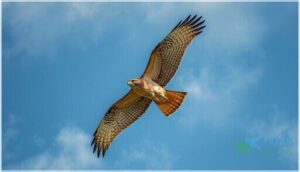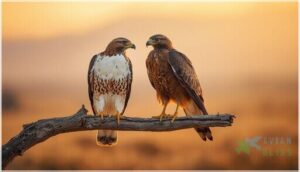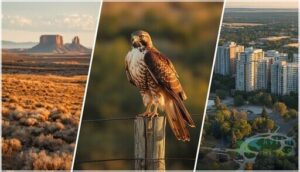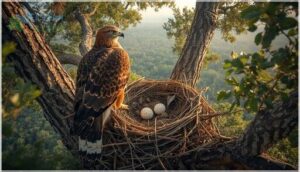This site is supported by our readers. We may earn a commission, at no cost to you, if you purchase through links.
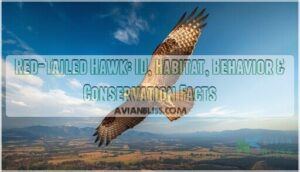
You might spot one soaring overhead with barely a wingbeat, holding steady on thermals while scanning the ground from hundreds of feet up. The red-tailed hawk owns the skies across nearly every corner of North America, from Alaska’s tundra edges to Florida’s subtropical wetlands.
That rust-colored tail catches sunlight like a beacon, but it’s just one clue in a surprisingly complex identification puzzle. These raptors shift appearance based on age, geography, and color morph—meaning two individuals can look strikingly different even when perched side by side.
Understanding what sets them apart opens up a clearer picture of one of the continent’s most adaptable predators.
Table Of Contents
- Key Takeaways
- Red-Tailed Hawk Identification
- Physical Characteristics and Variations
- Habitat, Range, and Migration
- Behavior and Hunting Habits
- Breeding, Conservation, and Population
- Frequently Asked Questions (FAQs)
- What is a red-tailed hawk?
- Where do red tailed hawks live?
- What Raptor is a red tailed hawk?
- How old is a red tailed hawk?
- Is a red tailed hawk a hawk?
- Do rufous tailed hawks have a red tail?
- How rare is it to see a red-tailed hawk?
- Can a red-tailed hawk pick up a cat?
- What does it mean when you see a red-tailed hawk?
- Are red-tailed hawks aggressive?
- Conclusion
Key Takeaways
- Red-tailed hawks display remarkable plumage variation across 14 subspecies and three color morphs, with identification requiring attention to tail color, belly bands, and patagial marks that shift with age, geography, and individual genetics.
- These adaptable raptors compress their home ranges to one-third normal size in urban settings, successfully hunting rats and pigeons from building ledges while facing elevated mortality from vehicle strikes and rodenticide poisoning.
- Sexual dimorphism drives specialized hunting roles, with females weighing 25-30% more than males and targeting larger prey while males pursue smaller, more agile animals—a division that maximizes feeding efficiency across their territory.
- Despite localized population declines at 41% of monitoring sites, the species maintains “Least Concern” conservation status with over 3 million individuals thriving across North America, though rodenticide exposure affects 58% of sampled hawks through contaminated prey.
Red-Tailed Hawk Identification
You’ll recognize a red-tailed hawk by its stocky build and signature rust-colored tail, but identifying one isn’t always straightforward. These raptors show considerable variation in appearance depending on age, region, and color morph.
Here’s what to look for when you spot one soaring overhead or perched along the roadside.
Size and Shape Comparison
At first glance, you’ll notice a Red-tailed Hawk is built like a linebacker among raptors. These stocky buteos measure 45–65 cm long, with wingspans reaching 110–145 cm—roughly between a crow and a goose in overall size. Sexual dimorphism is clear: females tip the scales 25% heavier than males. Their broad wings and short, fan-shaped tail create a distinct soaring shape.
They thrive across diverse habitats, and their habitat distribution spans North America.
Plumage and Color Patterns
Red-tailed Hawks show stunning plumage variation you won’t see in most raptors. Light-morph birds dominate across the range, displaying whitish underparts with a brown belly band and dark patagial marks along the underwing. Western calurus populations include dark morphs and intermediate (rufous) morphs, while pale Krider’s types appear in the northern Great Plains. They’re familiar North American raptors, commonly observed.
Regional variations reflect geography:
- Eastern forms – narrow belly bands with cleaner white underparts
- Western birds – heavier streaking and more rufous on shoulders
- Harlan’s types – marbled or banded tails instead of uniform red
- Krider’s hawks – pale dorsally with faint pinkish tail wash
Adult coloration develops after the first molt at 1–2 years, when the characteristic rufous tail replaces brown juvenile plumage. Dark morphs appear nearly uniform brown below, masking the belly band entirely.
Juvenile Vs. Adult Appearance
Age tells a clear story in plumage timing. Juvenile red-tailed hawks exhibit brown tails with 5–9 dark bars, pale yellow iris coloration, and heavier underpart streaking across the breast. Adults, on the other hand, display uniformly red tails, dark brown eyes, and cleaner white chests with defined belly bands. Wing molt patterns also differ—juveniles carry uniform flight feathers, while adults show mixed ages.
| Feature | Juvenile | Adult |
|---|---|---|
| Tail Banding | Brown with 5–9 dark bars | Solid brick-red with single subterminal band |
| Iris Coloration | Pale yellow to straw-colored | Rich dark brown |
| Underpart Streaking | Heavy, diffuse mottling across breast | Clean upper breast, defined belly band |
| Wing Molt | Uniform juvenile feathers (no gaps) | Annual molt with mixed feather ages |
| Identification Timing | Full juvenile plumage at 2–3 months | Adult appearance by 2.5 years |
Key Field Marks
Beyond age cues, you’ll want to focus on five diagnostic marks. The tail coloration—rufous with a narrow black band in adults—separates red-tailed hawks from similar buteos.
Look for the belly band across the mid-abdomen, the dark patagial bar along each underwing’s leading edge, pale scapular patches forming a broken “V,” and that compact flight silhouette with broad, rounded wings held in a slight dihedral.
Physical Characteristics and Variations
You already know what a Red-tailed Hawk looks like from a distance, but the details tell a richer story.
These raptors aren’t one-size-fits-all—they vary in weight, wingspan, coloring, and even between males and females. Let’s break down the measurements and variations that make each hawk unique.
Body Measurements and Wingspan
You’ll notice red-tailed hawks are built like compact powerhouses. When you’re measuring these Buteo hawk proportions, body size and wingspan work together to create that unmistakable silhouette:
- Body length stretches 45–65 cm (18–25 inches)
- Wingspan variation ranges 110–145 cm (43–57 inches)
- Weight spans 690–2,000 grams (1.5–4.4 pounds)
- Wing chord measures 325–445 mm
These hawk physical characteristics place red-tailed hawks among North America’s larger buteos.
Sexual Dimorphism
When you spot a female red-tailed hawk next to her mate, she’s noticeably larger—up to 25–30% heavier. This size disparity means females handle bigger prey, while males chase smaller, quicker targets. Plumage won’t help with identification, though. Both sexes share the same rusty tail and mottled patterns across every morph and subspecies. Researchers rely on DNA sexing and morphometrics accuracy because plumage overlap makes visual sexing unreliable, even with ecological roles considered.
| Trait | Male | Female |
|---|---|---|
| Body Mass | 690–1,300 g | 900–2,000 g |
| Body Length | 45–56 cm | 50–65 cm |
| Wing Chord | 325–395 mm | 365–445 mm |
| Prey Size | Smaller, agile | Larger, varied |
| Breeding Role | Provisioning flights | Nest guarding |
Subspecies and Regional Differences
You’ll find at least 14 recognized red-tailed hawk subspecies across their range, each shaped by geographic isolation and regional climate. Plumage variation runs from the pale B. j. kriderii of the northern Great Plains to the blackish B. j. harlani in Alaska.
Morphological differences appear even within single subspecies—B. j. calurus birds vary considerably in wing length and tarsus depth across western ecoregions.
Intergradation zones blur boundaries where neighboring races meet, creating genetic structuring that reflects ancient refugia and ongoing gene flow.
Light-Morph and Dark-Morph Descriptions
You’ll encounter three primary plumage morphs in red-tailed hawks: light, dark, and intermediate. Light-morph birds—comprising 80–90% of western populations—show pale breasts with dark belly bands and rufous tails. Dark-morph individuals display chocolate-brown underparts throughout, while intermediate morphs exhibit rich rufous tones.
Plumage melanization remains stable over a hawk’s lifetime, with morph ratios varying by region and linked to precipitation patterns.
Habitat, Range, and Migration
Red-tailed hawks aren’t picky about where they live, which is one reason you’ll spot them almost anywhere across North America. From windswept deserts to city parks, these adaptable raptors have carved out a home in nearly every habitat type on the continent.
Let’s look at where you’re most likely to find them and how their movements change with the seasons.
Preferred Habitats
You’ll find red-tailed hawks thriving in open areas like grasslands and shrublands, where roughly 75% of their home ranges unfold. They favor edge habitats—those boundary zones where forests meet fields—and don’t shy away from urban adaptation in suburban settings.
Elevation factors barely limit them; they nest from sea level to alpine zones. Their habitat preferences center on land cover that offers perching spots and clear sightlines for hunting.
North American Distribution
You’re looking at a hawk whose geographic range blankets nearly all of North America. Red-tailed hawks breed from central Alaska through Canada’s southern provinces into Mexico and Central America, with winter residency now increasing northward due to climate impacts.
Their geographic distribution shows considerable range expansion:
- Continental reach – breeding pairs occupy habitats from Alaska’s Yukon to Panama and the West Indies
- Dense populations – central and eastern United States support especially high regional density
- Urban adaptation – metropolitan areas now host stable breeding populations
- Northern shift – migration range maps reveal more individuals overwintering in mid-latitudes
- Habitat flexibility – successful occupancy spans deserts, forests, grasslands, and cities
Urban Vs. Rural Presence
Red-tailed hawks now compress their home ranges to roughly one-third the rural size when they move into cities, exploiting concentrated prey around parks, cemeteries, and corporate campuses. Urban adaptation brings you face-to-face with these raptors hunting rats and pigeons from building ledges instead of rabbits in open fields.
However, mortality factors—vehicle strikes, window collisions, and rodenticide poisoning—escalate sharply where human interaction intensifies across densely built landscapes.
Seasonal Migration Patterns
Migration patterns vary dramatically by latitude—north of 38°N, most red-tailed hawks you’ll encounter leave winter breeding grounds entirely, while southern birds often stay put. Climate shifts are nudging these raptors to winter closer to home, shortening traditional migration distances by roughly 5.65 km annually.
Migration distances and age-related behavior you should know:
- Juveniles travel up to 1,462 km from natal nests during first summer movements
- Northern Alaska populations spend 42 fewer days on breeding territories than southern counterparts
- Timing movements peak between late June and early August for young hawks
- Most tracked migrants summer in Great Basin Desert and Columbia Plateau regions
- Territorial adults cease long-distance migration, remaining within 203 km of natal areas
Red-tailed hawk migration range maps now show expanding northern winter populations alongside declining southern migration counts—80% of birds banded south of 38°N actually move north in summer, flipping assumptions about latitudinal strategies.
Behavior and Hunting Habits
Red-tailed hawks are skilled hunters that rely on patience and precision to catch their prey. Their hunting methods, diet, and territorial behavior reveal why they’re such successful predators across North America.
You’ll often spot them soaring high on thermals or perched on fence posts, scanning the ground below.
Soaring and Perching Techniques
You’ll often spot Red-tailed Hawks circling high on thermals and updrafts, their broad wings and distinctive flight pattern making them easy to identify. This soaring energetics strategy conserves energy while they scan for prey and conduct territory surveillance.
When hunting strategies shift, they’ll select elevated perches—utility poles or tall trees—spending nearly 80% of daylight hours perched, waiting to strike. Environmental effects like wind velocity strongly influence their shape and hunting mode choice.
Prey Detection and Capture
Once perched, you’ll witness their remarkable visual acuity in action. Red-tailed Hawks possess binocular vision with a double fovea, detecting prey movements from over 10 meters high. Their sensory adaptations include UV light perception, tracking urine trails invisible to other predators.
Red-tailed hawks use binocular vision with a double fovea to detect prey movements from over 10 meters high, even tracking UV-visible urine trails
They employ four hunting strategies—perch strikes being most effective—achieving roughly 79% capture success. That sit-and-wait approach maximizes efficiency while monitoring environmental interaction patterns below.
Diet and Prey Selection
When you observe their feeding behavior, you’ll find small mammals—especially mice, voles, and ground squirrels—dominate their diet, sometimes reaching 85% of prey items in grassland regions. Their red-tailed hawk diet is sensitive to local abundance:
- Urban prey like rats and pigeons fuel city hawks
- Seasonal shifts increase bird captures in warmer months
- Prey size ranges from 28g mice to 2.3kg jackrabbits
- Carrion use supplements hunting success during harsh winters
Regional variation shapes hawk diet and hunting patterns across their range.
Aggressiveness and Interactions
Though red-tailed hawks maintain territories of 0.85 to 3.9 square kilometers, their aggressiveness varies by context. Females defend nests more fiercely, while males patrol territory boundaries. This avian predator faces mobbing behavior from crows—sometimes 100 birds strong—forcing relocation rather than retaliation. Human interactions at airports have caused $52.7 million in aircraft damage, highlighting conflict zones where hunting and feeding behavior overlap with infrastructure.
| Interaction Type | Aggression Level | Primary Responder |
|---|---|---|
| Nest defense | Moderate (2.2/4 scale) | Female |
| Territory boundaries | High aerial displays | Male |
| Crow mobbing | Defensive retreat | Both sexes |
| Human proximity | Variable avoidance | Context-dependent |
Breeding, Conservation, and Population
Red-tailed hawks build their nests high in trees or on cliff ledges, laying two to three eggs each breeding season. You’ll be glad to know their populations are actually growing across North America, with over three million birds now thriving in the wild.
Let’s look at how these adaptable raptors are managing in our changing world and what threats they still face.
Nesting and Reproduction
Red-tailed hawks form strong pair bonding relationships, with many couples staying together for years. You’ll find their stick nests high in trees, roughly 30–90 feet up, where both partners participate in nest construction.
The female lays 2–3 eggs and undertakes most incubation for 28–35 days. Nestlings develop over six weeks before fledging, though they’ll stick around for another month or two, learning to hunt.
Population Trends and Estimates
You might be surprised that the global population of red-tailed hawks hovers around 2.3 million breeding individuals. Migration counts reveal a mixed picture—while 58% of monitoring sites show stable numbers, regional declines hit 41% of locations.
The Raptor Population Index and eBird data track these shifts, helping researchers assess conservation status. Despite localized hawk population decline, overall trends suggest hawk population recovery across most of North America.
Conservation Status and Threats
You’ll be glad to know red-tailed hawks hold a “Least Concern” IUCN Status, backed by Legal Protection under the Migratory Bird Treaty. Yet conservation challenges persist:
- Rodenticide Poisoning affects 58% of sampled hawks through contaminated prey
- Collision Mortality from vehicles, turbines, and power lines
- Habitat Fragmentation in urban sprawl zones
- Climate Impacts shifting suitable ranges
- Pesticides causing sublethal harm
Climate change and ongoing threats demand continued vigilance despite stable conservation status.
Human Impact and Adaptability
You might wonder how raptors thrive beside highways and skyscrapers. Red-tailed hawks show considerable long-term adaptability to human landscapes. Legal protections under the Migratory Bird Treaty help, but anthropogenic mortality factors—shootings, collisions, lead poisoning—still threaten populations.
Urban nesting success varies: suburban hawks benefit from abundant prey in lawns and grassland-agriculture mosaics, while diet shifts reflect ecosystem changes. Their conservation depends on reducing rodenticides and preserving habitat edges.
| Impact Type | Challenge | Adaptation Response |
|---|---|---|
| Urban development | Reduced nesting sites above 0.53 density index | Use of utility poles, building ledges |
| Collision hazards | Vehicle strikes, window impacts | Selective territory placement in semi-open zones |
| Prey availability | Diet shifts in human-modified landscapes | Hunting rodents in lawns, agricultural fields |
| Chemical threats | Rodenticide exposure, lead contamination | Population resilience through high reproductive output |
Frequently Asked Questions (FAQs)
What is a red-tailed hawk?
You’re looking at one of North America’s most widespread raptors: the red-tailed hawk (Buteo jamaicensis).
This large buteo hawk dominates open habitats from Alaska to Panama, recognized instantly by its signature rufous tail.
Where do red tailed hawks live?
You’ll find these hawks across the Americas, from Alaska to Central America, thriving in open or semi-open landscapes. They adapt to diverse biomes, cities, and altitudes, reflecting considerable geographic range and habitat preferences despite habitat fragmentation.
What Raptor is a red tailed hawk?
You’re looking at a Buteo, specifically Buteo jamaicensis—one of North America’s largest soaring hawks.
This raptor belongs to the order Accipitriformes and family Accipitridae, sharing classification with eagles and Old World vultures.
How old is a red tailed hawk?
Red-tailed Hawks reach surprising ages—the oldest recorded survived over 30 years. Most live 10 to 21 years in the wild. Juveniles fledge around 6 weeks, changing to adult plumage by 5 years.
Is a red tailed hawk a hawk?
Yes, the red-tailed hawk is a true hawk, classified in the genus Buteo within the family Accipitridae.
Its broad wings, chunky build, and hunting behavior exemplify classic hawk morphology and ecological niche.
Do rufous tailed hawks have a red tail?
Picture a sliding scale of warm earth tones—that’s where you’ll find these hawks.
Rufous-tailed hawks display reddish-brown tails, similar to their red-tailed cousins, bridging the color spectrum between rufous and classic red in Redtailed Hawk identification.
How rare is it to see a red-tailed hawk?
You’ll spot red-tailed hawks often across North America—they’re the continent’s most common large raptor.
Their population exceeds 3 million, with sighting frequency peaking near 96% during fall migration at key observation sites.
Can a red-tailed hawk pick up a cat?
Despite folklore, your full-grown cat is safe. Hawks can’t lift prey over 5 pounds routinely. Kittens under five pounds face predation risk, but adult cats exceed hawk lifting limits considerably.
What does it mean when you see a red-tailed hawk?
Seeing a hawk often connects to spiritual symbolism and cultural beliefs about inner wisdom, ancestral messages, and personal growth.
Your identification of this behavior in its habitat might signal heightened awareness or important life changes ahead.
Are red-tailed hawks aggressive?
Hawks don’t usually stalk humans like they do rodents—thank goodness. Red-tailed hawks occasionally defend nests by striking passersby, but attacks remain rare. Most aggression occurs when you’re near active nests during breeding season.
Conclusion
Picture a hawk spiraling upward on invisible air, reading wind patterns you’ll never feel. That kind of mastery comes from millions of years of fine-tuning.
The red-tailed hawk proves adaptation isn’t just survival—it’s thriving in farmland, forest, and even city skylines.
You’ve now got the tools to recognize these raptors anywhere they hunt. Next time one crosses overhead, you’ll see more than wings and tail feathers—you’ll see precision in motion.
- https://www.audubon.org/field-guide/bird/red-tailed-hawk
- https://www.dimensions.com/element/red-tailed-hawk-buteo-jamaicensis
- https://www.allaboutbirds.org/guide/Red-tailed_Hawk/lifehistory
- https://www.hawkmountain.org/raptors/red-tailed-hawk
- https://www.fs.usda.gov/rm/pubs_other/rmrs_2006_gatto_a001.pdf

